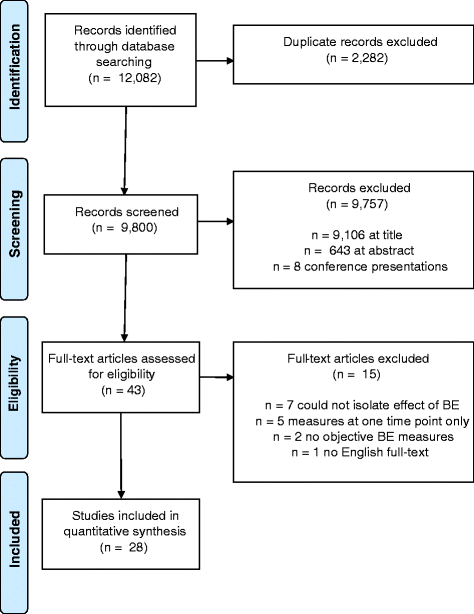Systematic literature review of built environment effects on physical activity and active transport - an update and new findings on health equity
- PMID: 29145884
- PMCID: PMC5693449
- DOI: 10.1186/s12966-017-0613-9
Systematic literature review of built environment effects on physical activity and active transport - an update and new findings on health equity
Abstract
Background: Evidence is mounting to suggest a causal relationship between the built environment and people's physical activity behaviours, particularly active transport. The evidence base has been hindered to date by restricted consideration of cost and economic factors associated with built environment interventions, investigation of socioeconomic or ethnic differences in intervention effects, and an inability to isolate the effect of the built environment from other intervention types. The aims of this systematic review were to identify which environmental interventions increase physical activity in residents at the local level, and to build on the evidence base by considering intervention cost, and the differential effects of interventions by ethnicity and socioeconomic status.
Methods: A systematic database search was conducted in June 2015. Articles were eligible if they reported a quantitative empirical study (natural experiment or a prospective, retrospective, experimental, or longitudinal research) investigating the relationship between objectively measured built environment feature(s) and physical activity and/or travel behaviours in children or adults. Quality assessment was conducted and data on intervention cost and whether the effect of the built environment differed by ethnicity or socioeconomic status were extracted.
Results: Twenty-eight studies were included in the review. Findings showed a positive effect of walkability components, provision of quality parks and playgrounds, and installation of or improvements in active transport infrastructure on active transport, physical activity, and visits or use of settings. There was some indication that infrastructure improvements may predominantly benefit socioeconomically advantaged groups. Studies were commonly limited by selection bias and insufficient controlling for confounders. Heterogeneity in study design and reporting limited comparability across studies or any clear conclusions to be made regarding intervention cost.
Conclusions: Improving neighbourhood walkability, quality of parks and playgrounds, and providing adequate active transport infrastructure is likely to generate positive impacts on activity in children and adults. The possibility that the benefits of infrastructure improvements may be inequitably distributed requires further investigation. Opportunities to improve the quality of evidence exist, including strategies to improve response rates and representativeness, use of valid and reliable measurement tools, cost-benefit analyses, and adequate controlling for confounders.
Keywords: Causation; Cycling; Health equality; Playgrounds; Urban form; Walkability; Walking.
Conflict of interest statement
Ethics approval and consent to participate
Not applicable.
Consent for publication
Not applicable.
Competing interests
The authors declare they have no competing interests.
Publisher’s Note
Springer Nature remains neutral with regard to jurisdictional claims in published maps and institutional affiliations.
Figures
References
-
- World Health Organization. Global recommendations on physical activity for health. Geneva; 2010. - PubMed
-
- Lee I-M, Shiroma EJ, Lobelo F, Puska P, Blair SN, Katzmarzyk PT. Lancet physical activity series working group: effect of physical inactivity on major non-communicable diseases worldwide: an analysis of burden of disease and life expectancy. Lancet. 2012;380:219–229. doi: 10.1016/S0140-6736(12)61031-9. - DOI - PMC - PubMed
-
- Ding D, Lawson KD, Kolbe-Alexander TL, Finkelstein EA, Katzmarzyk PT, van Mechelen W, Pratt M. Lancet physical activity series 2 executive C: the economic burden of physical inactivity: a global analysis of major non-communicable diseases. Lancet. 2016;388:1311–1324. doi: 10.1016/S0140-6736(16)30383-X. - DOI - PubMed
Publication types
MeSH terms
Grants and funding
LinkOut - more resources
Full Text Sources
Other Literature Sources
Medical


